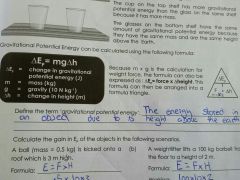![]()
![]()
![]()
Use LEFT and RIGHT arrow keys to navigate between flashcards;
Use UP and DOWN arrow keys to flip the card;
H to show hint;
A reads text to speech;
26 Cards in this Set
- Front
- Back
|
Distance |
A measure of how far an object has traveled or the amount of space between two objects. Measured in Metres, (M) |
|
|
Time |
A measure of how long an object has been traveling for. Measured in seconds (s) |
|
|
Speed |
A measure of the rate of motion of an object. The distance covered divided by time taken. Measured in Metres per second (ms-1) |
|
|
Velocity |
Speed in a given direction |
|
|
Acceleration |
The rate of change of velocity or speed per unit of time. Measured in Metres per second per second. (Ms-2) |
|
|
Deceleration |
The rate of decreasing velocity or speed per unit of time |
|
|
Distance - Time graph |
A graph used to show the distance an object has traveled over a period of time. Can be used to determine the speed of an object. |
|
|
Speed-time graph |
A graph used to show the speed an object has traveled over a period of time. Can be used to calculate the distance an object has traveled. |
|
|
Force |
A push, or a pull that causes an object to undergo a change in direction or a change in shape measured in Newtons (N) |
|
|
Balanced forces |
Occurs when the sum of all forces on an object equals zero and the objects motion does not change. It has a constant velocity or stationary. |
|
|
Unbalanced forces |
Causes a change in motion in an object because the forces acting on an object aren't equal. |
|
|
Newton |
The SI unit for force. Named after Sir Isaac Newton (N) |
|
|
Thrust |
To push an object in a particular direction |
|
|
Mass |
The amount of matter contained with an object. Measured in kilograms (Kg) |
|
|
Weight |
The force of gravity acting on an objects mass. Measured in Newtons ( N ) calculated with the formula F=Ma |
|
|
Friction |
The resistance that one surface or an object encounters when moving over another. It is a force that opposes the movement of an object |
|
|
Drag |
A force that opposes the motion of an object that slows it down |
|
|
Pressure |
Force per unit area. Calculated using the formula P=F/A Measured in Newtons per square Metre (Nm-2) |
|
|
Energy |
Energy is the ability to do work. Measured in Joules ( J ) |
|
|
Joule |
The SI unit for work or energy named after James Joule |
|
|
Gravitational potential energy |
The energy stored in an object due to its height above earth. Ep=mgh |
|
|
Kinetic energy |
The energy of an object due to its motion. Ek= 1/2mv^2 |
|
|
Work |
When force (s) moves an object resulting in the transfer of energy to that object. W=Fd measured in Joules |
|
|
Power |
The rate of doing work, or the rate of transfer of energy. It is calculated with, P=w/t measured in watts ( W ) |
|
|
Watt |
The SI unit of power ( W ) |
|
|
Gpe/force (mass×gravity)/height formula |

|

